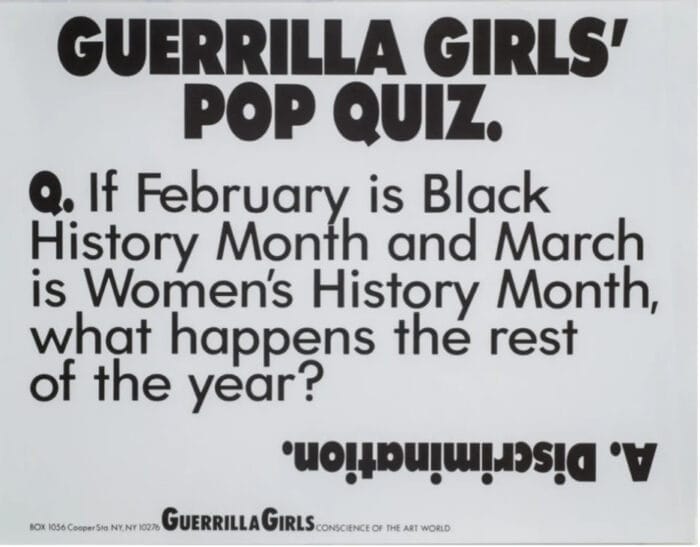
WHEN:
April 12–September 28, 2025
WHERE:
National Museum of Women in the Arts
1250 New York Avenue
NW, Washington, D.C
TICKETS:
$16+
For more information and tickets visit the National Museum of Women in the Arts website.
A spokesperson describes the event as follows:
"...Guerrilla Girls: Making Trouble showcases more than 30 iconic prints and objects from 1985 through 2007.
The Guerrilla Girls burst into the art world in 1985 with bold text- and graphic-based prints denouncing discrimination. The group, a collective of anonymous feminist-activist artists, formed in the wake of the Museum of Modern Art’s 1984 exhibition An International Survey of Recent Painting and Sculpture. Although the exhibition claimed to represent the “best” artists of the time, only 13 of the 169 artists were women. In response, the Guerrilla Girls pasted posters onto walls throughout Lower Manhattan decrying the museums, galleries and critics enabling or participating in inequitable treatment of women and artists of color. With eye-catching aesthetics and stark statistics, the Guerrilla Girls became a global force for change, holding installations and demonstrations around the United States and abroad. Many of the topics that the Guerrilla Girls addressed in the 1980s and ’90s—reproductive rights, the environment, and political corruption, to name a few—are still pressing today.
To protect their identities, members of the Guerrilla Girls adopt as pseudonyms the names of deceased historical women artists, such as Alma Thomas, Käthe Kollwitz and Frida Kahlo, and wear gorilla masks during public appearances. Known for their provocative street campaigns and advertising-style graphics, they project their messages across billboards, buildings, banners and other sites, bringing widespread attention to issues of inequality and inequity.
Drawn from NMWA’s deep holdings of work by the Guerrilla Girls, the exhibition presents a visual timeline of the group’s progress and ever-expanding subject matter. The installation, presented in the museum’s new MaryRoss Taylor Galleries within the Gloria and Dan Logan Learning Commons, begins with a selection of prints from their earliest series, “Guerrilla Girls Talk Back.” Completed between 1985 and 1990, these works speak directly to arts institutions, patrons and artists. What Do These Artists Have in Common? (1985) brazenly names artists who allow their work to be shown in galleries that discriminate against women. Guerrilla Girls’ Pop Quiz (1990) asks, “If February is Black History Month and March is Women’s History Month, what happens the rest of the year?” (The answer, in bold type: “Discrimination.”)
While the Guerrilla Girls do not shy away from blunt confrontation, they also employ humor to point out hypocrisy and double standards. Guerrilla Girls’ Code of Ethics for Art Museums (1990) features two screen-printed stone tablets, listing sardonic tenets such as, “Thou shalt provide lavish funerals for Women and Artists of Color who thou planeth to exhibit only after their Death.” Long before the age of shareable social media posts and viral memes, the Guerrilla Girls used outrageous graphics and biting barbs to ensure that their messages were memorable and widely shared.
Later objects, from the early 2000s, show the gradual progress the group has encountered since their founding. Benvenuti alla Biennale Femminista! (2005) addresses the Venice Biennale. Appearing as picketers, the masked Guerrilla Girls hold signs that draw attention to the historical underrepresentation of women and artists from non-Western countries in the national pavilions of the famed international exhibition. The placards exemplify the group’s acknowledgment of change (one reads, “Women Directors at Last!”), while still holding the art world accountable (“Who cares if they’re introduced as ‘the Spanish girls’ at press conferences!”). The Guerrilla Girls take a populist approach to their work, and the exhibition will also showcase a selection of mass-produced objects designed by the group. Small rubber erasers declaring “Erase Discrimination” wittily combine material and text to exhort people to action..."


